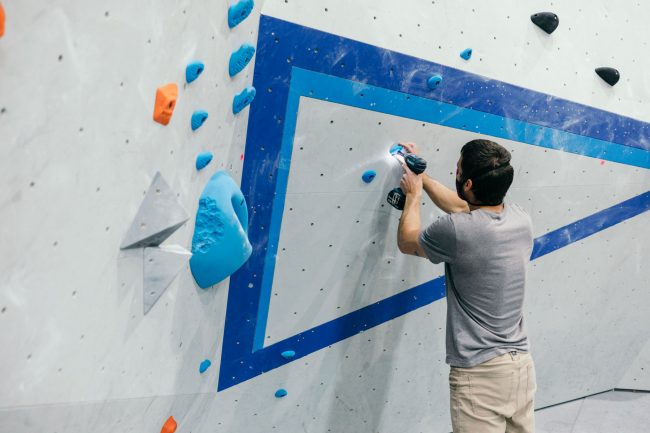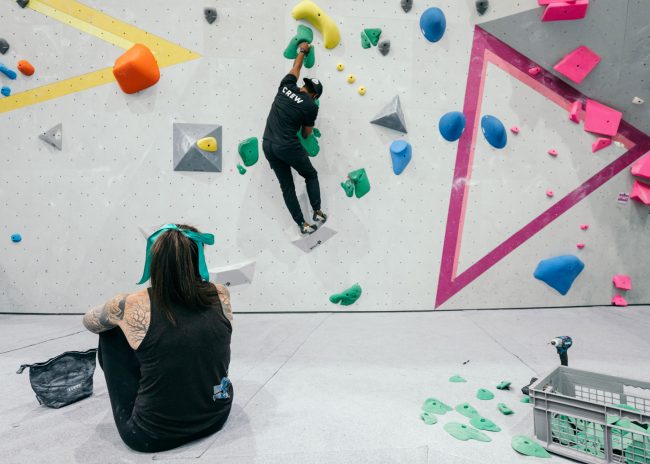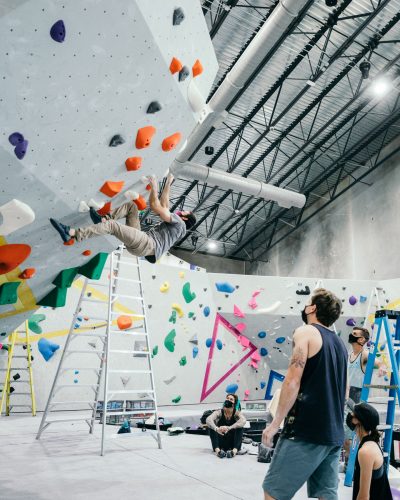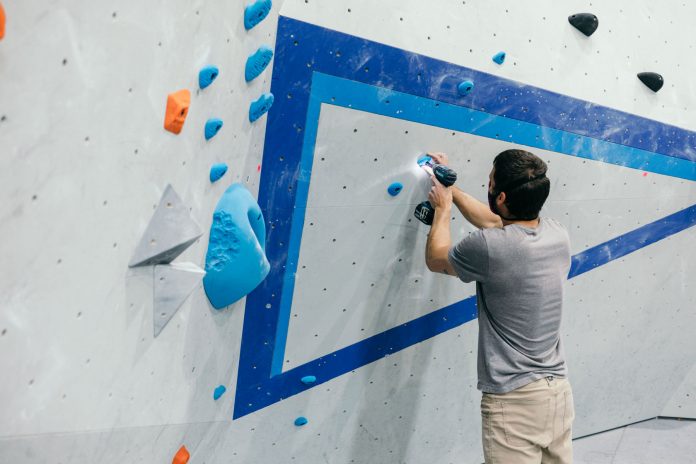Ask A Setter…supports routesetters who are interested in developing their skillset, at various stages of their setting careers. In this edition, routesetting expert Louie Anderson points out common mistakes for setters to avoid when just getting started, but the tips are good reminders for experienced setters as well. Got a question you’d like an outside opinion on? Email us your routesetting question here.

QUESTION: “What common mistakes do you see with beginner routesetters?”
ANDERSON: As with any new practice, there are several job-specific things that must be learned with experience and time spent making mistakes. These include proper tool usage, safety practices, and other technical considerations. These will come with time, and by working with more experienced setters as mentors. Let’s instead focus on a few that are more fundamental and have greater impacts on the final product and how the end users (climbers) experience what is set.
Difficulty: Maintaining Internal Consistency Is Not Easy
Certain assumptions, personal opinions, and misunderstandings on the part of the new routesetter can greatly impact the difficulty of the climbs set and how they are received by the gym community.
Every gym seems to have their own interpretation and opinion on how grades should be presented in their facility. Sometimes they even have their own grading scale that steps away from traditional grading systems in use for outdoor climbing.
As a new setter, it may take a while to fully understand the grades in your workplace. Until you learn to better understand movement and the difficulty presented by your hold inventory on different wall angles, you will surely miss the mark from time to time.
Consistent Grading Keeps Regulars Happy
Perhaps nothing upsets gym climbers more than climbs not being graded appropriately. I don’t personally care much if a gym chooses to grade stiff (sandbagged) or soft (easier) compared to outdoor grades. What I do think should be the goal in every gym though is achieving consistency with how climbs are graded and presented to the public. And even more challenging will be maintaining parity over time, as routes changeover at different intervals and by different hands.
Learn to rely on the opinions of the other setters on your team and make the necessary changes to your climbs during the forerunning process to get them where they need to be. Regular gym visitors and members will make an adjustment (if needed) to their personal interpretations of grades, and will come to know what to expect at a given facility.
Use Movement to Teach Beginners
Easier climbs do not need to be absolute jug ladders. This (to me) is lazy setting. How will your climbers learn to move better and read sequences if you don’t present them with challenges?

Push yourself to produce quality climbing on easier grades. Maybe a flat or sloping hold can still be used securely if it is paired with large footholds that support your climber’s weight better. If the walls are steep enough to make jugs your primary hold choice, consider a line that includes some lateral movement.
Remember too that beginning climbers don’t usually have a broad understanding of movement, and that introducing matching, crossovers, underclings, sidepulls and other non-ladder movements may be enough to introduce some variety and challenge to your climb―and to allow it to stand out as different and more rewarding to those climbing it.
Good Climbers Want More Than Big Spans to Small Holds
In a similar way, harder climbs do not need to be comprised of small and hard-to-use holds, spaced far apart. More advanced climbers understand movement very well, and they will not be put off by more intricate sequences, big sloping holds, or pairing huge holds with small and hard-to-use feet.
Challenging climbing does not need to be relative to the size of the holds used. The more you can break away from generic ideas of what makes climbing hard, the more your setting will be appreciated by better climbers.
Size Dependency: Setting for Other Body Types Is Not Easy
Size dependency is often simplified as a climb being “reachy,” but it’s so much more than that. Tall climbers can get bunched up, climbers with small hands cannot use wide pinches and slopers with the same security as those with larger hands, and of course shorter climbers may not be able to make the span to the next hold.
In general, it’s likely that much of your first setting experiences will result in climbing that is comfortable and offers well-spaced movement in relation to your own body size, spans and preferences. Especially if you are a taller person, you may inadvertently set climbs that have built-in size dependency until you learn not to.
Setting climbing movement that is relatively fair to different-sized climbers is a talent, and usually takes some time and the making of mistakes to be able to do well. Again, a good starting point for developing this awareness and the requisite skill to succeed will likely come from discussions with your setting teammates, and targeted tweaks during the forerunning process.

Learn from Others Climbing Your Routes
Many gyms make an effort to employ setters of different body sizes and types to allow for a greater consensus skill level across the setting team, in the hope that these issues can be avoided (or resolved easily as they occur).
If you find yourself challenged in this way with your setting, seek the feedback of climbers in your problem size range, and listen to what they have to say. It’s also very helpful to watch people on your climb. Where are they having issues, and why? Ask them what could be done to “fix” the issue.
A big part of developing and progressing as a setter is honest feedback. If you want to improve, set your ego aside and listen to this feedback. It can come from your teammates, Head Setter, the gym community, or your friends. Whatever the source, listen and absorb what makes sense to move your abilities forward. If size-dependent setting is an issue for you, pair up with someone of a different size and set climbs together, with a special intent to avoid replicating your past mistakes in this area.
It Takes More Than an Extra Foot
Some setters throw extra feet on a climb and call it good. While that may be the right approach in some cases, you can usually avoid a line of foot options with some extra thought and a better understanding of movement and other possible solutions.

Louie Anderson has been climbing since 1974 and routesetting for over 35 years. He’s a big proponent for education in the setting world, having written The Art of Coursesetting (re-released as Fundamentals of Routesetting). Anderson has also been shaping holds and consulting for gyms for decades. His holds are available at Legacy Ascension, and more information about his services is at louieandersonclimbing.com.
Listen to our podcast with Louie: Revitalizing Routesetting for the Next Generation











